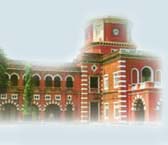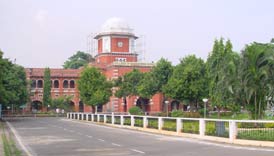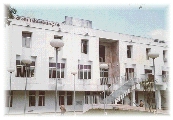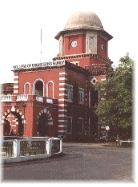| As a Student.... Anna University & MIT I grew up as a student with immense interest in Mathematics and Science from my school days. With such an interest, I had no hesitations in choosing the Science stream in my pre-university level. I started building a strong foundation for my future in Science. I always approached the subjects with an analytical and logical angle. My teachers complimented me for being innovative and intuitive rather than being a "stick-to-book" person. I understood that my future lay in Engineering, which is a confluence of Science and Mathematics. My hard work and determination helped me get admission in Anna University, one of the far-famed universities in India. I joined Anna University in June 1999 for my Bachelor of Technology (B.Tech) course in Instrumentation Engg. Anna University is one of the pioneer engineering institutions in India. It stands third among the Non-IITan colleges in India. Instrumentation Engg course is offered by Madras Institute of Technology (MIT), one of the 3 colleges that constitutes Anna University, the other two being the College of Engineering, Guindy and Alagappa College of Technology. MIT by itself has a very rich history and tradition. It was founded in 1949 by Sri.C.Rajam. Our batch (1999-2003) was the Golden Jubilee Batch of MIT. MIT has a praise-worthy Alumni group. It was from this institute Dr. APJ Abdul Kalam, the honorable President of India and rightly acclaimed as the Father of Indian Science, got his Engineering foundation. He graduated from the Aeronautics Engg Department of MIT. His contributions to the development of Science and Technology in the field of space research are commendable. It was indeed a privilege to have studied in such a renowned institution. Another alumnus who has turned the attention of the world of Electronics towards him is Mr.K.B.Chandrasekar. He is the co-founder of Exodus Inc and Jamcracker, both based in the USA. Instrumentation Instrumentation Engineering basically deals with the measurement and control of various physical parameters that we come across in a wide variety of industrial applications. Since the measurement and control of parameters cannot be limited to a mechanical or an electrical or a computer domain, we were exposed to various concepts and techniques in all the domains. We had very experienced professors specialized in these areas and I got a good environment to hone my technical skills. I stood as one among the top 3 ranks in my class of 46 students for the B.Tech program. During the four-year study, we had several courses that covered the following areas: Basic Engineering, Mathematics, Electrical Engg, Electronics, Transducers & Sensors, Industrial Instrumentation, Control Systems, Process Control, Adaptive Control Systems, Computer Organization, Operating Systems, Networks, Artificial Intelligence, Biomedical Instrumentation etc., I developed special interest for subjects like Robotics, Control, Artificial Intelligence and took efforts early from my sixth semester to build a strong foundation for my career in these fields. Project My interest in the field of Robotics made me do my final year project on "Parallel Control of Robot Arms". It was done under the guidance of Dr.S.Renganathan, the then Dean of Anna University and currently the Dean of Bharat Institute of Engineering and Technology. He is a person who has professionally excelled himself in the field of Robotics and Control for over 3 decades. I started this project with the main intention of making the two robots in our department usable, as they had remained inoperable for around 7-8 years. We had to spend nearly 2-3 months of the initial phase on reconstruction of the robots in which we concentrated on both mechanical and electronic renovation. Then an entire control unit was designed and developed using multiplexing logic. We created a user interface to control the motion of the arms by sending control signals from the PC. The signal was given as a word byte depending upon the arm selected for action using Visual C program. We were able to control 36 different combinations using the 2 robots of 6 DoF each. Later the program was modified to do specific tasks like fitting a bolt and a screw, a pen and its cap and so on. When we succeeded in this we programmed the robot for repetitive action initially for a fixed number of times and later for a variable number of times terminated by the user interruption on pressing a specific key. Our project has set up a foundation for the restoration of the Robotics Laboratory in our department. Now the lab is actively operated for the juniors who are working towards an advanced feedback control of the manipulators. Our Head of the Department was very happy on the completion of the project against all odds and nominated our project as one of the best projects of the year. During the Industrial Instrumentation course of my final year, I got an idea of designing a new method of ratio control without the use of conventional flow meters by using the simple physical relation that exists between the height of liquid column and velocity of flow. I got this idea after I heard a lecture from Dr.P.Kanagasabapathy where he rightly pointed out that the high cost involved with achieving ratio control is attributed to the indispensable requirement of flow meters to control the flow. Later, I discussed my ideas with the professor. He was very impressed with the idea and suggested me to take up my final year project on this subject. However, since by then I had already decided to do the Parallel Control of Robot Arms as my final year project, he recommended another batch in our class to take up this project. So I had to work simultaneously on two projects for the final year. This ratio controller was an online controller and the control action was taken continuously and instantaneously for changes in set point or disturbances to the wild flow. My idea that was theoretically proven also succeeded practically. We were able to achieve ratio control to a high degree of precision and accuracy. I had to wait till the completion of that project to send the thesis of the project along with the experimental verifications for publication. Publications Based on the above 2 projects, I submitted two papers for publication in national level journals. The paper titled "PC based Parallel Control of Robot Arms" has been provisonally accepted in The Journal of Institute of Electronics and Telecommunication Engineers, India (IETE). It was co-authored by Dr.S.Renganathan (ex-Dean, Anna University) and Mr.N.Selvaganesan. The paper titled "A Novel Method of Ratio Control without using Flow meters" has been published in The Journal of Instrument Society of India, India (ISOI). This paper was co-authored by Dr.P.Kanagasabapathy and Ms.L.Sridevi (one of the members of the Ratio control project team). I also submitted another paper titled "Design and Simulation of Fuzzy Logic Control System for Robotic Two-Link Manipulators" to ISOI, which also is co-authored by Dr.S.Renganathan and Mr.N.Selvaganesan. Recently I have presented 2 papers titled "Fuzzy Based Robust Controller Design for Robotic Two-Link Manipulator" and "Online Tuning of PID Controller for Time Variant Systems using Genetic Algorithm" in the International Conference On Artificial Intelligence In Engineering And Technology (ICAIET) - Malaysia- August 2004. Both these papers are co-authored by Dr.S.Renganathan and Mr.N.Selvaganesan. I have also presented a couple of papers titled "Intelligent Behavior Based Robot Navigation using Fuzzy Logic Approach" and "Long Distance Control of Tele autonomous Systems in situations of Intelligence Failure" in National level Technical Symposiums and won prizes for the same. |
| Related Links: |
 |
 |



